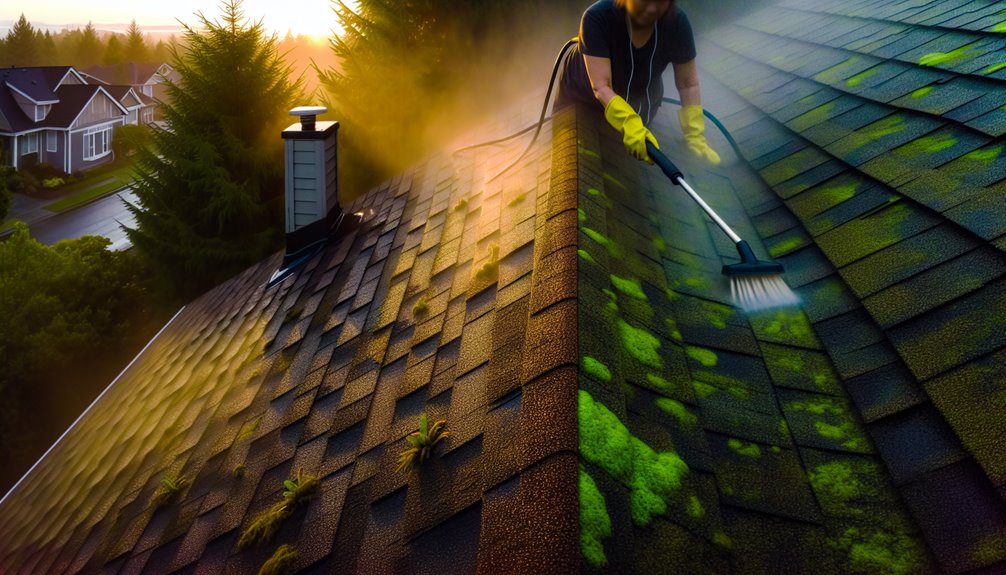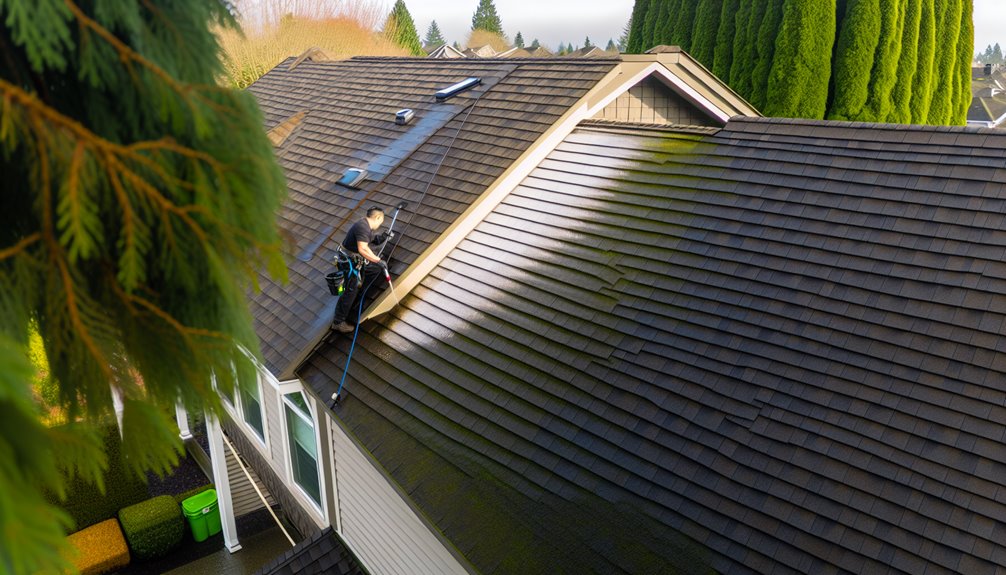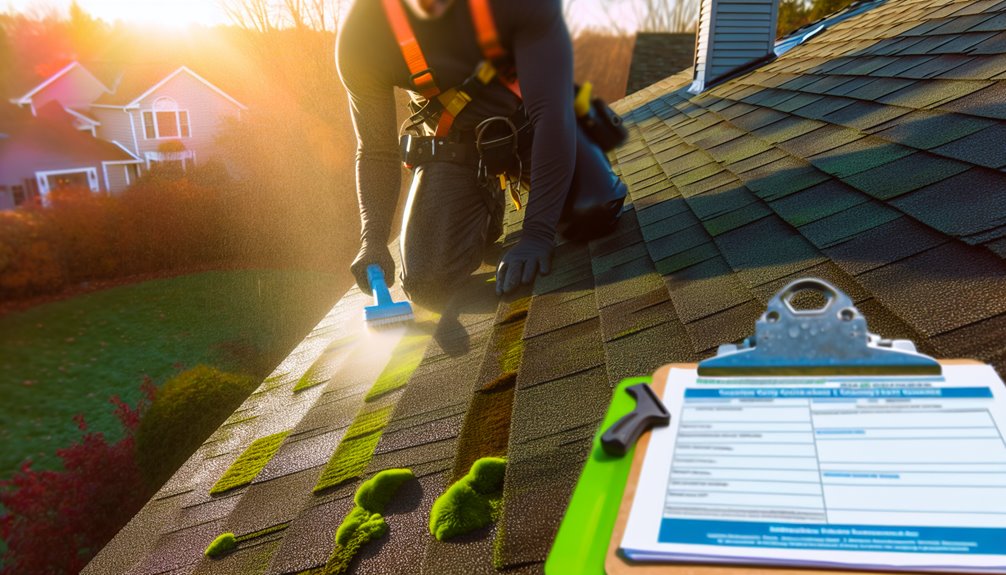Like a slow leak, humid air quietly feeds roof growth you can’t ignore. In warm, shaded, pollen‑coated areas, algae, moss, mildew, and lichen trap moisture, roughen shingles, and cut reflectance, risking leaks and higher cooling loads. You need safe, manufacturer‑approved soft‑wash methods, clear gutters, trimmed branches, and balanced attic ventilation to stop the cycle without voiding warranties. Know the signs, avoid high‑pressure damage, and time cleanings right—because the next rainy season won’t wait.
Why Humid Climates Accelerate Roof Growths

Often, persistent humidity turns your roof into a microhabitat where algae, moss, mold, and lichen thrive. In humid climates, Moisture retention keeps shingles damp, reducing dry-out cycles that normally inhibit Spore proliferation. Warm, shaded sections trap vapor, while capillary action wicks water into granules and overlaps. Nutrients from pollen and dust accumulate, fueling biofilms. As growths spread, they roughen surfaces, slowing runoff and increasing water load, which elevates slip and structural risks.
You can serve homeowners well by controlling humidity drivers: improve attic ventilation, clear debris, trim overhanging branches, maintain gutters, and select algae-resistant materials. Schedule gentle, professional cleanings to protect roof integrity.
Identifying Moss, Mildew, Algae, and Lichen on Roofs
Sometimes the first clue is color and texture: algae appears as dark streaks or a uniform black-green film; mildew shows as light gray or white powdery patches; moss forms thick, spongy, bright-green clumps with tiny stems; lichen presents as flat, crusty or leafy plaques in pale green, yellow, or bluish tones. Check north-facing slopes, drip edges, and shaded valleys first. Document black streaks along shingle granules; note moss at overlaps and under flashings. Avoid brushing dry growths—spore dispersal increases. Use binoculars from the ground, then photograph patterns for planning. If unsure, test a small, wet area to confirm texture before treatment.
Risks to Shingles, Structure, and Energy Efficiency

Even before leaks appear, biological growth and moisture in humid climates degrade roofing systems and raise energy bills. Moss wicks water under tabs, accelerating shingle deterioration, loosening fasteners, and exposing underlayment. Algae and mildew trap heat, reduce solar reflectance, and force HVAC systems to work harder. Persistent dampness invites wood rot at decking and rafters, risking structural compromise and unsafe load paths. Wet insulation loses R-value, driving heat gain and condensation. You can protect occupants and property by scheduling inspections, documenting surface conditions, clearing debris, maintaining gutters, improving attic ventilation, and addressing ponding. Early action limits damage scope, preserves warranties, and lowers lifecycle costs.
Safe, Manufacturer-Approved Cleaning Methods
Before you reach for a pressure washer or harsh chemicals, align your approach with roofing manufacturers’ guidance to protect materials and warranties. Use a soft wash process and only manufacturer approved cleaners to lift biofilm without stripping granules or corroding metals. Work methodically, protect landscaping, and prioritize fall protection and ladder safety.
- Verify your shingle brand’s bulletin; confirm dilution ratios, dwell times, and compatible nozzles.
- Apply low-pressure (under 100 psi) soft wash from the eave upward; rinse downward to avoid intrusion.
- Isolate gutters; divert runoff; neutralize overspray.
- Document batch mixes, photos, and lot numbers to maintain warranty compliance.
Prevention Strategies: Tree Trimming, Drainage, and Ventilation

From the eaves to the attic, prevention starts with reducing moisture and shade that feed algae, moss, and rot. You’ll protect people and property by managing three systems: trees, water, and airflow. Maintain canopy clearance so sun reaches shingles and branches can’t abrade granules. Install gutter guards to keep channels open, reducing overflow that wets fascia and sheathing. Confirm downspouts discharge away from the foundation, and correct slope grading to move water outward. Inside, verify balanced intake and exhaust; pair clean soffit vents with continuous ridge vents to purge humid air. Document schedules, use PPE, and monitor after storms.
DIY Pitfalls and When to Call a Professional
While DIY roof cleaning can look straightforward, the risks multiply fast on wet, pitched surfaces and with chemicals that can etch shingles or corrode flashing. You want to serve your household well, but DIY mistakes like using high-pressure washers, mixing oxidizers and acids, or walking on brittle tiles cause leaks, electrical hazards, and Warranty voiding. Call a pro when you face height, fragile roofing, heavy moss, or nearby solar, skylights, and gutters needing protection.
- Identify material: asphalt, tile, metal—each needs specific chemistry and pressure.
- Confirm safe anchors, footwear, and fall protection.
- Use manufacturer-approved cleaners.
- Stop if granules or coatings shed.
Maintenance Schedules and Long-Term Protection Plans

Now that you know when DIY stops making sense, set a cadence that prevents buildup and extends service life. Plan seasonal inspections—spring for post-storm damage, late summer for heat-stress checking, and late fall for leaf-related moisture traps. Schedule gentle, manufacturer-approved cleanings annually in humid zones; biannually for heavy shade or nearby trees. Specify soft-wash chemistries compatible with your shingles, document photos, and log service dates for warranty compliance. Add zinc or copper strips at ridge lines to inhibit regrowth. Clear gutters quarterly. Train volunteers on ladder safety and fall protection, or outsource. Bundle multi-year service to lock pricing and response priority.
Conclusion
As the proud owner of Hydra Clean here in Hattiesburg, MS, I truly understand the importance of keeping your roof in top shape, especially in our humid climate. By taking a proactive approach, we can work together to prevent any unwanted growths and ensure your roof remains strong and reflective. If you ever feel overwhelmed or unsure about tackling these tasks, remember I’m just a call away! I invite you to visit myhydraclean.com or give me a ring at (601) 336-2411. Let’s chat about how we can protect your home together—because your peace of mind is our priority!

